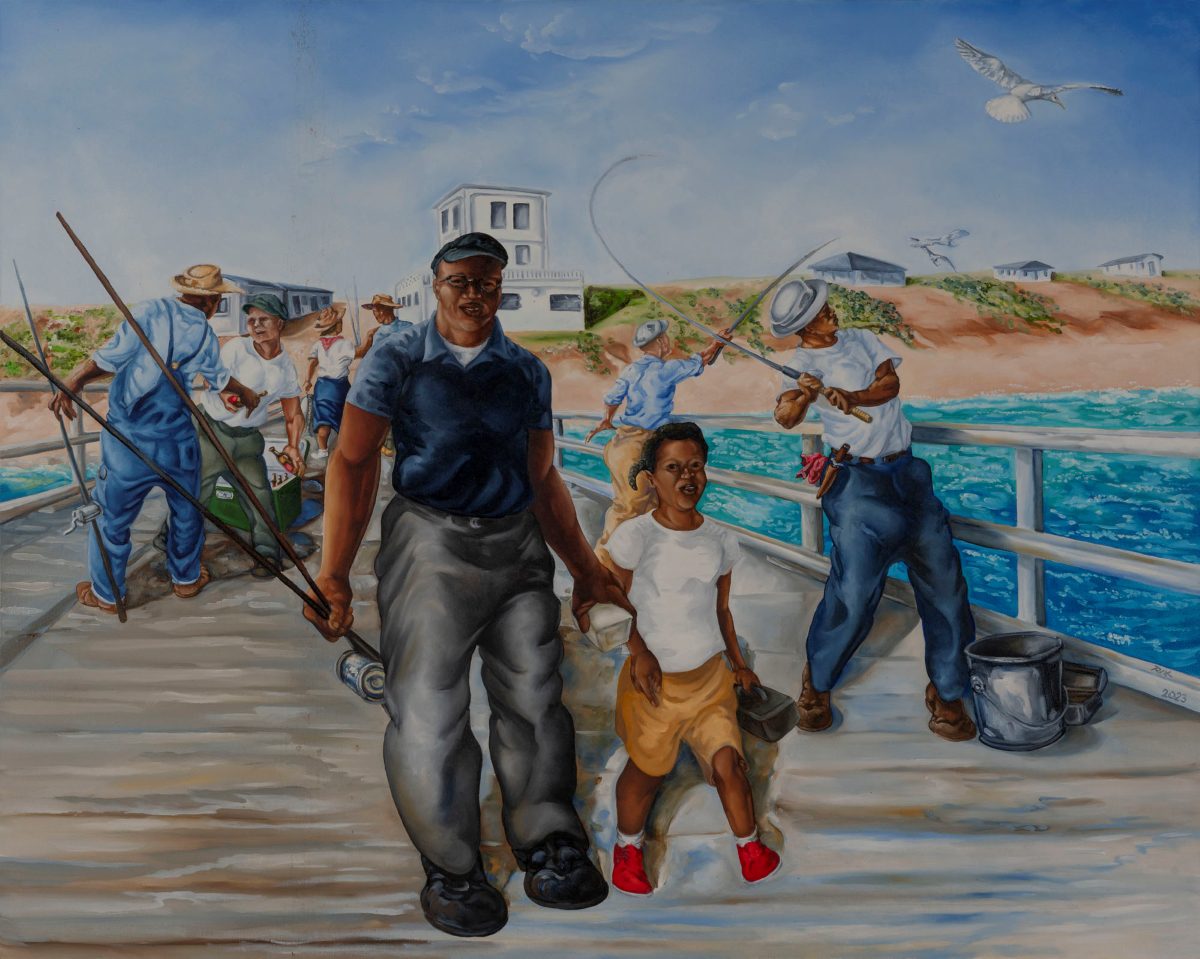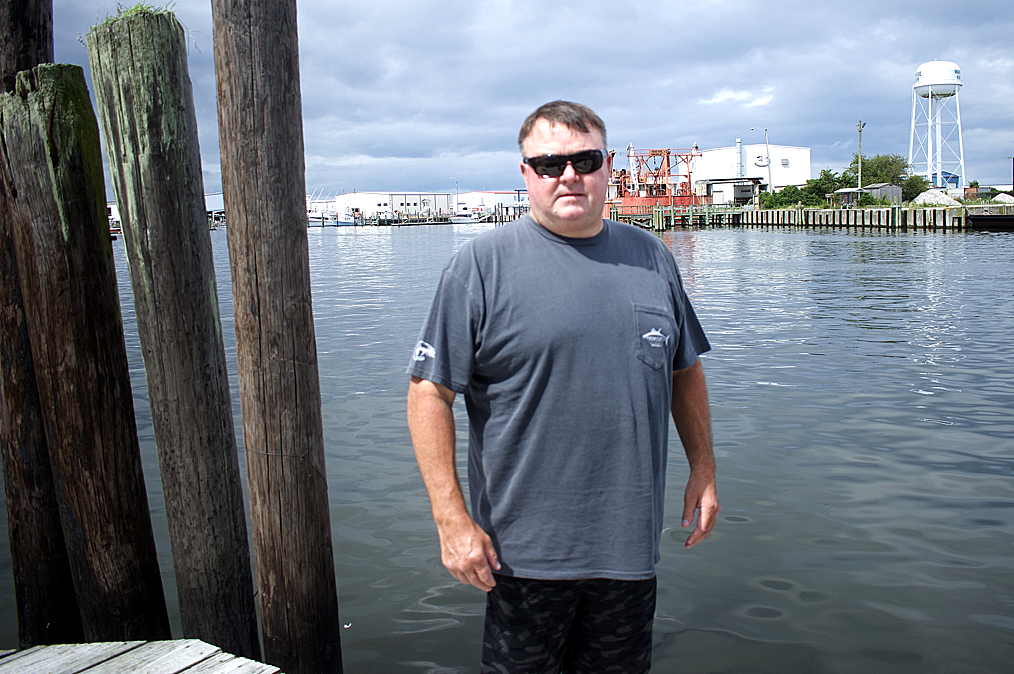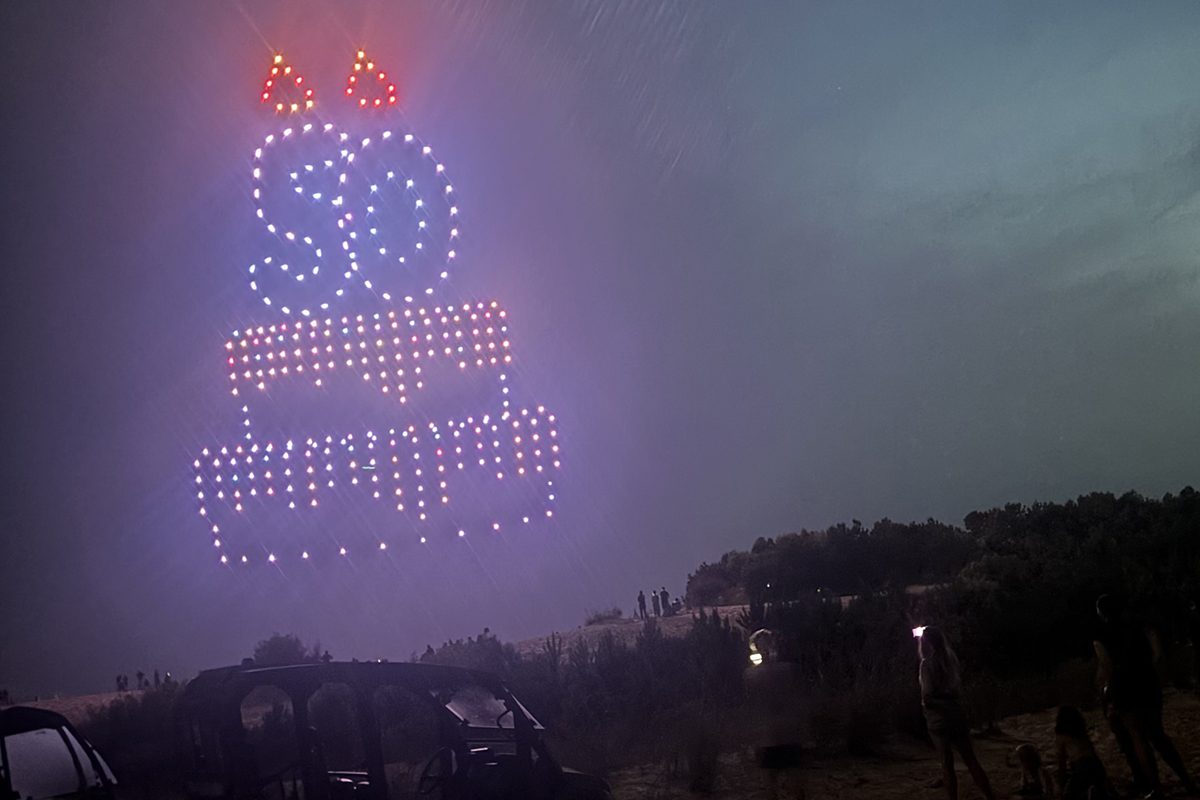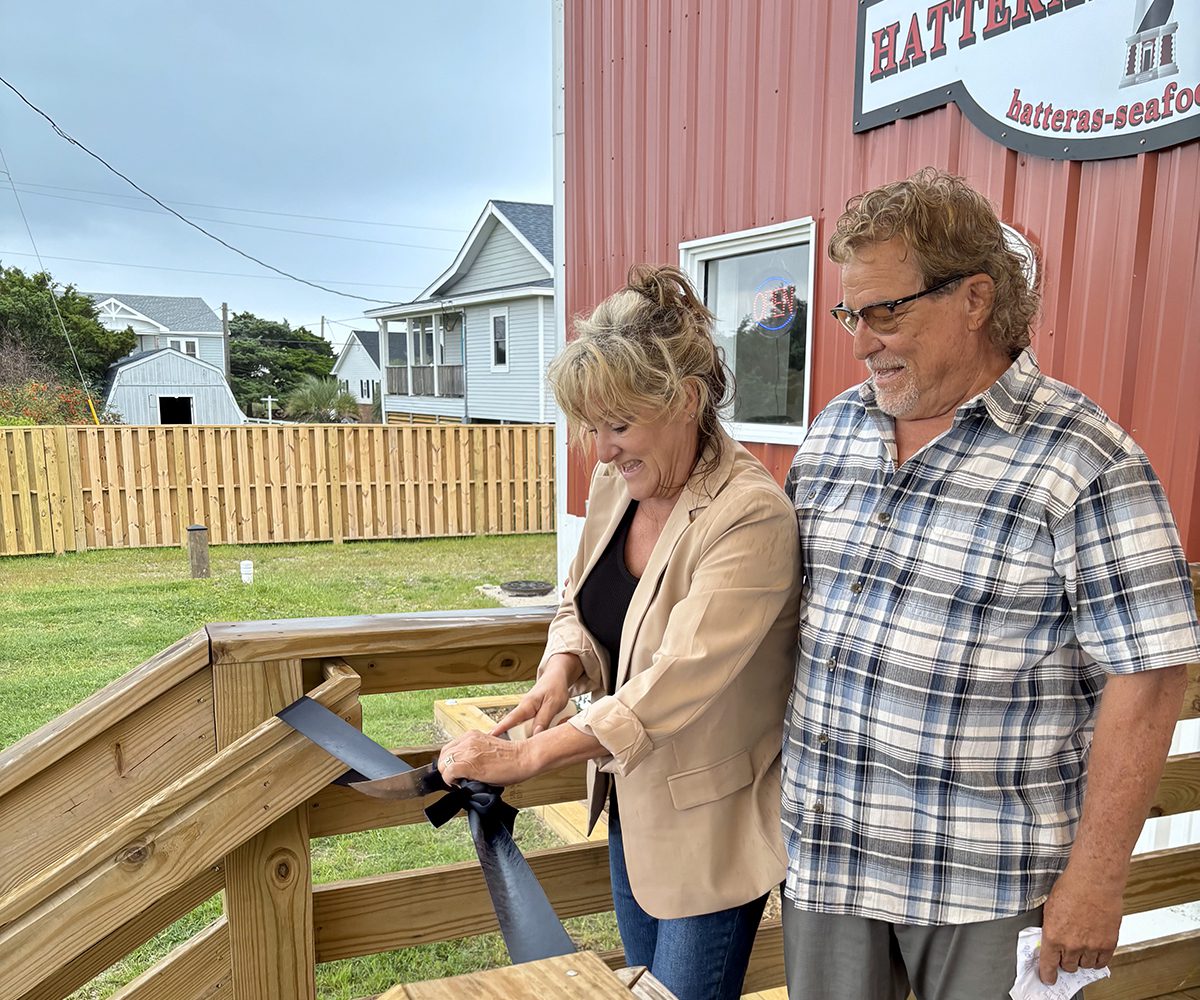
BEAUFORT — Keith Rittmaster walks 50 feet into the woods, shovel in hand, as he leads the way along a rough path of orange flags.
“We’re going to go to my graveyard,” he explained.
Supporter Spotlight
The orange flags are really carefully labeled grave markers, noting the location of long-departed dolphins and whales. He talks about this arrangement as if it’s totally normal to keep marine mammal bones buried in the woods.
Amid the intense August heat and humidity, mosquitoes swarm as I’m tasked with the job of digging up the arthritic vertebrae of a dolphin. Rittmaster works on exhuming a pygmy sperm whale.
Rittmaster is a natural science curator for the North Carolina Maritime Museum, and his office is a trailer on an empty lot in Beaufort. The office is cluttered with books, binders of dolphin photos, marine mammal bones, artifacts, tooth molds and monofilament fishing line. One corner is completely taken up by the bones of Pitfall, a 37-foot female humpback whale that died from a ship strike.
There’s no running water or nearly enough room for his bone collection. Its location, however, is not without its amenities. It’s only 100 feet from his graveyard.
Rittmaster has many duties at the museum — educator, researcher, conservationist and bone expert – but much of his work revolves around protecting dolphins and whales. That earned him a Pelican Award from the North Carolina Coastal Federation last month. When he received the letter informing his of the award, Rittmaster thought it was a mistake. He replied to Lauren Kolodij, deputy director of the federation, in confusion.
Supporter Spotlight
“And I told Lauren, ‘There must be some mistake, Pelican Awards are just for cool people who are talented and bright. And I’ve done nothing to distinguish myself, so I think there’s been a mistake’,” he said.
Sam Bland, coastal specialist with the federation and former superintendent at Hammocks Beach State Park down the coast in Swansboro, said one reason Rittmaster was chosen was because he saw a problem plaguing marine mammals and did something about it by creating the North Carolina Monofilament Recovery and Recycling Program.
“It had enough effect on him that he didn’t just sit back and complain,” Bland said.
Collecting Fishing Line
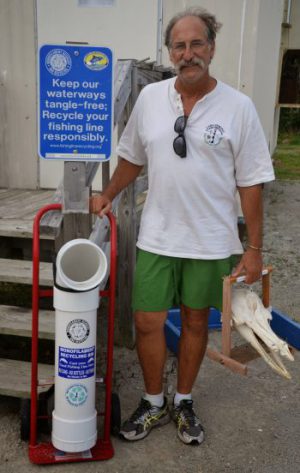
About 30 volunteers have placed 42 bins along the coast to collect, so far, 2,400 miles of fishing line. This prevents the line from ending up in waterways and harming animals, such as birds, turtles and marine mammals, something Bland saw over the years at the state park.
The fishing line is then sent to Berkley, a fishing company that recycles the line into underwater “fish-habs” that attract fish and encourage plant growth to create a fish habitat.
Rittmaster chuckled at the notion that he was recognized “For Dedication to the Research and Protection of Marine Mammals.” He pointed out that most of the marine mammals he encounters are already dead.
“I think it slipped the Coastal Federation’s radar that most of the marine mammal saving I do is bone,” he said.
Rittmaster is also well-known for studying bones and putting them back together for display, a process known as rearticulation. He works with a variety of people on these projects, including “volunteers, students, colleagues, co-workers, family, experts, and sometimes even people off the street,” he said.
This isn’t a job most people aspire to. There was no hint while growing up in Princeton, New Jersey, that life would lead Rittmaster, 59, to trailer in Beaufort putting together dolphin bones. “Growing up I hated museums and I had no interest in bones or anatomy,” he said. “In fact, I thought it was macabre whenever I saw animal bones on display in someone’s home.”
It all changed in 1975 when Rittmaster, then 17, moved to Buxton on the Outer Banks. He started surfing among dolphin and saw his first whale stranding.”
Since then, his years of experience have made him a point of contact for bone work.
“If someone from National Marine Fisheries is responding to a ship-struck fin whale, I usually get a phone call (saying), ‘Hey Keith, you want this thing?’ It doesn’t happen that often, but I’m becoming the go to person for bone work,” he said.
The third re-articulation he worked on — Bonehenge, a 33.5-foot male sperm whale, named Echo, that hangs in the heart of the North Carolina Maritime Museum — was documented over the course of eight years, from the whale’s initial stranding to its final home in the museum. The whale heart is also displayed.
Morbid work for some but Rittmaster think his efforts help make sure that these deaths are not in vain.
As part of his job as a natural science curator, he also is the director of the Cape Lookout Studies Program and does bottlenose dolphin photo identification. He is also a member of the North Carolina Marine Mammal Stranding Network and the Atlantic Large Whale Disentanglement Network
Colleagues and friends of Rittmaster say there are many reasons his work his valuable, from his commitment to making information accessible, to his infectious enthusiasm for what he’s teaching.
“There are other individuals who work with cetaceans, but few have the passion for studying these creatures that Keith has consistently shown down through the years,” said John Hairr, museum curator at the North Carolina Maritime Museum and Rittmaster’s supervisor.
Scientific Collaboration
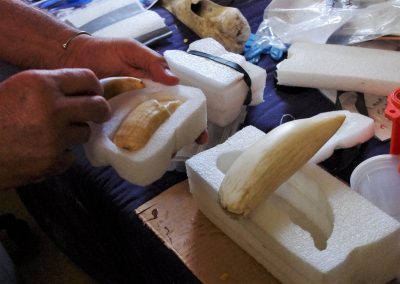
Rittmaster said he wants to make the information about marine mammals available to the public so that it can be used for research and education. Hairr echoed this.
“Keith has the rare combination of being a top-notch researcher with an eagerness to share his knowledge with folks from all walks of life, regardless of background, education level or other factors,” he said.
All of the specimens he buries are from local stranding responses. He has a diverse group — six specimens from five species.
“We used to respond to strandings to learn about whales and maybe affect conservation, but we would leave the skeletons on the beach, or we’d bury them, or we’d tow them out to shore. And it’s such a waste,” Rittmaster said.
A better use is to bury them for a few years to remove the flesh. He then digs them up and gives them to interested researchers. Or sometimes, if the specimen is especially unique, he makes displays. One he’s currently working on is what’s called an offshore form of a bottlenose dolphin, but really, he says it’s an unidentified species that only looks similar to a bottlenose dolphin.
On this particular August morning, when the dolphin vertebrae were exhumed from his graveyard after 22 months in the ground, he said he was going to take photos of them and send the bones over to Craig Harms, the director of the marine health program at Center for Marine Sciences and Technology in Morehead City.
“I’m going to present it to Craig and he’s going to say, ‘What the hell is that?’”
Harms said he will forget about a certain stranding, and then a couple of years later, Rittmaster will say the bones are ready to be examined. He said bone analysis can be very important when figuring out what caused a marine mammal’s death.
“I don’t have the patience or, really, the setup to do that, and he’s keeping track of all these burials and with all the exhumations,” Harms said. “I would be interested in seeing that when it’s ready, but I just can’t deal with it over the next two years.”
The Dolphin Lineup
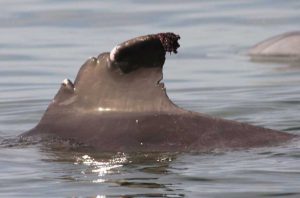
Rittmaster’s bottlenose dolphin photo ID program is also helpful in marine mammal research, said Vicky Thayer, the central coast marine mammal stranding coordinator for the Marine Mammal Stranding Network. She is in charge of strandings in the central coast area and Albemarle and Pamlico sounds. She also happens to be married to Rittmaster.
Since 1985, Rittmaster, Thayer, and others have collected binders full of bottlenose dolphin fin photos. Rittmaster said around 4,000 photos — representing about 1,200 dolphins — have been added to an online database that will allow people to help match the fin photos, and in turn, lead to discoveries in bottlenose dolphin migrations, associations, genetic stocks and birthrates.
Rittmaster works closely with Nan Bowles on this project. She is an artist and able to recognize patterns and shapes, making her an asset to matching fin photos.
“The information that we learn about where the dolphins go and how they’re using the coast is used by the National Marine Fisheries to help determine fishing regulations. We’re not just doing this for the fun of it,” Rittmaster said.
Federal fish biologists also use it to learn about the genetic pools of bottlenose dolphin populations.
Thayer said the accessibility of this long-term information is a great enhancement to her and Harms’ work. She said Rittmaster’s work is important for offering more insight on what may have caused a stranding and, ultimately, the death of a marine mammal.
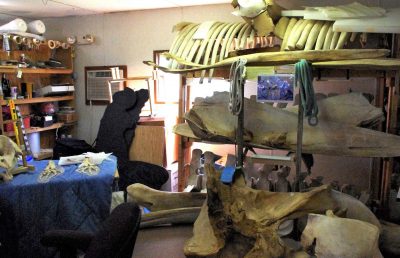
“His work is mostly collecting the really important data and sharing it openly over really long term with lots of researchers. It’s very rare that long-term photo ID studies continue as long as his has,” Thayer said.
But their partnership is also beneficial for the advancement of marine mammal knowledge, and has been ever since the two moved to Beaufort in the 1980s and took an interest in the local dolphins. That prompted them to start the photo ID program.
“We really like working together. We get along. I think we help each other be better at what we do, I think it’s good. We laugh a lot at ourselves,” Thayer said.
Rittmaster and Thayer met in graduate school at Duke University, where they worked at the same restaurant and swam laps at the same pool. They have two daughters, whose punishments for typical teenage transgressions would involve them having to tag along for stranding response. Though Rittmaster and Thayer both have jobs that focus on marine mammals, their interests do diverge.
“The stranding stuff is her strength and passion; that I have figured out how to make it part of my job is helpful. It helps everything. It helps the public,” Rittmaster said.
Thayer likes performing necropsies. As for Rittmaster, “he doesn’t like the gore,” she said. But necropsies don’t necessarily reveal all of the information, so Rittmaster can help on that front.
“People say that the necropsy isn’t complete until you’ve looked at the skeleton, too,” Thayer said.
This partnership helps advance the studies on marine mammals, such as their patterns, pathogens and human interactions. The dolphin vertebrae, for example, were sent to Thayer and Harms for further research. As for re-articulation, that’s not only educational, it’s also just fun and interesting.
Bones and Education
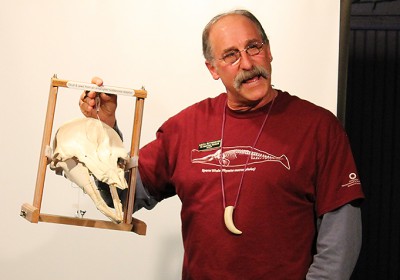
John Ososky, a museum specialist with the Smithsonian Institution, has known Rittmaster and Thayer for years. Rittmaster visits the Smithsonian Institution a few times a year to help move marine mammal bones. Ososky said from a scientific standpoint, re-articulation isn’t necessarily important. But from an education and outreach standpoint, it contributes a lot.
“A lot of times, these animals were injured and re-healed, or they ultimately died from some type of human interaction, and that can show up on the skeleton. He’s done a good job of presenting that and explaining why it’s important to alter the behaviors that led to that,” Ososky said.
Those who have gotten the chance to attend one of Rittmaster’s education events have probably met Lionel, a dolphin skull display that shows how the bone grew around a piece of fishing net.
“I like it when I build a display or tell a story that highlights a conservation issue,” he said.
At the Pelican Awards, with Lionel by his side, Rittmaster took the podium to plug the threats fishing line pose to marine mammals.
“I loved how he used his podium time to get that message out again. He’s not going to let any opportunity go to waste and get the word out of what the threats are,” Harms said.
Because of his collection, it’s guaranteed that Rittmaster can find a way to quiz people on their marine mammal knowledge. He can talk about whaling by using jars of spermaceti. He has a dolphin fin matching game — if you guess an incorrect match, a buzzer will sound.
He has whale parts such as baleen and a flesh-colored, rubbery aorta that belonged to Echo, the sperm whale hanging up in the museum. He also uses whale teeth to show the connection between age and tooth size.
This is perhaps his strongest area of expertise — how to engage people. Whether it’s talking to elementary, middle or high school students, leading workshops, or teaching a group of Harms’ veterinary students, those who know Rittmaster can’t deny his enthusiasm.
“Through his enthusiasm for education, he really makes a difference in being able to encourage others, and those are going to be the ones who are future stewards of the coastal resources,” said Bland, who presented him with the Pelican Award.
Thayer said both his passion and dedication are what makes his enthusiasm so “infectious.”
“I think he makes a difference just by being himself, and he’s so disarmingly honest and caring and hardworking, that it makes people want to work with him and volunteer for him and just be around him,” she said. “I mean, he’s just a really good guy.”



